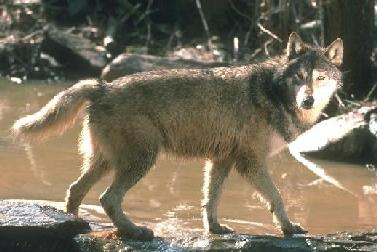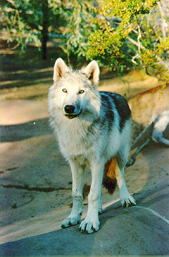Gray Wolf, Canis lupus
Geography 323: Biogeography
Spring, 1996
Dr. Cathy Whitlock
Group Members:
Melanie Lee Wadsworth Human Impact
Erin Leslie Barnhart Current Status
Joseph Ty Vrudny Modern Distribution
Owen Robert Smith Biogeographic History
Paul Schroder Life History

Human Impact
Human impact has seriously altered the distribution of the gray
wolf. Currently, the only distributions of the gray wolf that
resemble those of the past are found in areas that haven't been
heavily impacted by humans. These areas include Alaska (fig.1),
parts of Canada (fig.1) and the former USSR. According to Alderton
(1994) the gray wolf's range is "now significantly reduced,
particularly in Europe" (fig.2) and he notes, "the gray
wolf still has one of the widest distributions of all mammals,
occurring throughout the northern hemisphere above 15 degrees
N latitude." The gray wolf is endangered in Mexico and all
lower 48 states except Minnesota, where a population of 2000 exists
(Sheldon 1992). Sheldon (1992) also reports that small populations
can also be found in some areas in Europe.
In the contiguous United States (fig.1) wolves have
been found in Wisconsin, Michigan, Montana, and Minnesota, with
smaller populations and rare occurrences in Idaho, Washington,
Wyoming, North Dakota and South Dakota (U.S. Dept. of the Interior
& U.S. Dept. of Fish and Wildlife 1994). Finding accurate
statistics of wolf distribution by estimating their population
can be difficult. Wolves generally inhabit remote areas and are
capable of traveling over long distances (Paradiso & Nowak,
1982). Sheldon (1992) reports that in recent years this problem
of locating wolves has been improved through newer technology
that uses radiotelemetry which helps to organize data including, "wolf
movements, social organization, and habits."
In other parts of the world, the gray wolf is in serious
danger of extinction. Few individuals can be found in the Middle
East in the countries of Egypt, Jordan, and Syria. A much larger
population of about 1000 exists in India, but protection is not
enforced (Alderton, 1994).
In Europe, the only area with a considerable number
of wolves is in the eastern section, in the former USSR Scandinavia's
population of wolves may have increased due to wolves crossing
the border from the former USSR (Alderton, 1994). Alderton (1994)
suggests that the current distribution in Southern Europe is
"confined
essentially to the areas in the northwest of Spain, and the eastern
side of Portugal."
Modern Distribution
 The gray wolf has been pushed to the edge of extinction by humans
in almost every habitat it used to call home. "Worldwide,
wolves were once distributed everywhere north of about 20 degrees
N. latitude which runs through Mexico City and southern India"
(Hippomedia Corp., web site). Humans being at the top of most
food chains as well as the belief that we as humans are separate
from nature has led to the demise in gray wolf populations. "In
many countries, the wolf has long been gone. However, there are
still some 50,000 wolves in Eurasia, and about 50,000 in Canada,
and about 4,000-6,000 in Alaska. Mexico has less than a
dozen."(Hippomedia
Corp.)
The gray wolf has been pushed to the edge of extinction by humans
in almost every habitat it used to call home. "Worldwide,
wolves were once distributed everywhere north of about 20 degrees
N. latitude which runs through Mexico City and southern India"
(Hippomedia Corp., web site). Humans being at the top of most
food chains as well as the belief that we as humans are separate
from nature has led to the demise in gray wolf populations. "In
many countries, the wolf has long been gone. However, there are
still some 50,000 wolves in Eurasia, and about 50,000 in Canada,
and about 4,000-6,000 in Alaska. Mexico has less than a
dozen."(Hippomedia
Corp.)
In the United States there was mass extinction in a very short
time period. As the settlers moved West, they killed off much
of the main food supply of the wolf and became a competitor.
With nothing to eat they tried to survive by feeding on the settlers
livestock. This was a big mistake. They were then given the
bad name that they now have as a loathsome creature. The settlers
began the slaughter with massive hunting and poisoning campaigns.
"The poison campaign which killed upwards of two million
wolves in less than fifty years was already underway in the
mid-nineteenth
century"(Egan). "Today, about 2,000 wolves exist in
Minnesota, fewer than 20 on Lake Superior's Isle Royale, about
60 in Michigan's Upper Peninsula, 40 to 50 in Wisconsin, and about
65 in Montana. Numbers are low but unknown in Idaho and Washington,
and an occasional individual is seen in Wyoming, North Dakota,
and South Dakota"(U.S.F.& W.S. web site).
Populations fluctuate due to food availability and strife within
packs. The gray wolf is listed under the Endangered Species Act
as a threatened species in Minnesota, and as an endangered species
elsewhere in the lower 48 states. "Endangered" means
a species is considered in danger of extinction throughout all
or a significant portion of its range, and "threatened"
means a species is considered in danger of becoming endangered.
In Alaska, wolf populations number 5,900 to 7,200 and are not
considered endangered or threatened.
Biogeographic History

The first ancestor of Canis lupus was Miacis, "a
small, civet-like carnivorous mammal, with short legs and long
body, which lived some forty million years ago (Eocene-Oligocene
transition)" (Fox, 1971).
The first appearance of a species that was not a mixture of bear,
fox, etc., and wolf was the species Mesocyon coryphaeus.
"The fossil was dated to be 28.7 million years old and found
near the Turtle Cove member of John Day Formation, central
Oregon"
(Wang,1994).
"During the Oligocene period, two North American types emerged
from Miacis, one a large tailed Daphaenus, and a smaller
slender Cynodictis. From this arose two types in the lower
Miocene: Temmocyon, from which emerged the modern hunting
dogs of Africa and India: the second type, Cynodismus,
in North America, developed into enormous hyena-like animals.
An offshoot from Cynodismus in the upper Miocene emerged.
This was Tomarctus, from which developed fox and wild
dog" (Fox, 1971).
The range of Canis lupus has been affected by ice ages.
After the last ice age which occurred some 20,000 years ago,
the wolf population generally moved towards the poles. North
and South migration occurred.
Plate tectonics has had some effect upon that of Canis lupus.
Tectonic activity occurring 20 million years ago near present
day New England caused a change in range. The species
Cynodesmus,
hyena-like, eventually became extinct during this time period,
possibly because of the movement of the plate or plates.
Current Status

Gray wolves are listed as endangered in every state except Alaska
and Minnesota (in Minnesota they are listed as threatened with
a 1993 population of 1700). There is a large population of wolves
in Canada. In 1987, the U.S. Fish and Wildlife Service chose
three areas for wolf reintroduction. The Revised Northern Rocky
Mountain Wolf Recovery Plan would take place in Yellowstone National
Park, central Idaho wilderness, and the Northern Continental Divide
(which includes Glacier National Park). This recovery plan takes
place under the 1973 Endangered Species Act (Wilkinson, 1993).
The plan is to capture wolves in Canada and release 15
into Yellowstone and 15 into Idaho. Then, as long as there are
no more legal setbacks, they will reintroduce 15 more wolves in
each area every fall for the next 3-5 years. Hopefully, by the
year 2002, they would have 100 wolves in Yellowstone. This
reintroduction
is not only about reestablishing the species. According to the
source, "Returning wolves to Yellowstone and Idaho is, rather,
'a symbolic act, just as exterminating them in the West was a
symbolic act', says Rênee Askins, director of the Wolf
Fund"
(Begley and Glick 53). The authors believe that it is not about
"'saving' wolves", as there are 6,000 wolves in Alaska
and 55,000 wolves in Canada.
There were several opponents of this plan, such as livestock,
hunting, ranching, and Wise Use groups. The main fear of these
groups is the loss of livestock to wolves as they leave the park.
However, according to a study, wolves as an attraction in
Yellowstone
could generate $19 million which is much more than the estimated
amount of
losses of livestock. Furthermore, Yellowstone visitor were polled
and of approximately 35,000 people, 97% voted to reintroduce wolves.
Another argument to reintroduce wolves was to balance out the
population of other Yellowstone animals such as elk and bison.
The gray wolf is the only missing mammal from Yellowstone's
post-Pleistocene
ecosystem (Wilkinson, 1993).
As the government reintroduces wolves into Yellowstone
and Idaho, there is also a re-colonization effort by wild wolves.
Gray wolves have been living in Isle Royal National Park in Michigan
and in Voyageurs National Park in Minnesota as well. Furthermore,
there is a move of wolves from Canada down into Glacier National
Park and near North
Cascades National Park in Washington.
There have been successful reintroductions of other species
of wolves in the U.S. The red wolf has been successfully
reintroduced
into the Great Smoky Mountains National Park and in Alligator
River National Wildlife Refuge in Manteo, North Carolina.
Life History
Gray wolves are highly social animals. They form packs of from
2-12 individuals depending on the abundance of prey. The social
structure of the pack is a strict hierarchy controlled by an alpha
male. Within this pack structure only the alpha male and alpha
female are likely to breed, although all members of the pack will
take care of the pups. Wolves lead a complex social life. They
form groups called packs, which are typically composed of the
dominant mated pair (the alpha male and female), their offspring,
and an assortment of other adults, often with some genetic
relationship
to the alpha male and female.
In early summer the dominant female bears a litter of up to ten
pups. Dens are located in secluded locations. Life in summer centers
around this den site. The whole group assists in the upbringing:
helping to feed the mother and young with prey from the hunt,
caring for the pups when the mother herself goes hunting, and
guarding the area from predators like grizzly bears. By fall the
pups are able to roam freely and the group may become more nomadic.
Generally wolf pups will leave the pack when they are about a
year old. In packs without younger pups, however, the pups may
stay with their pack longer. Although many year old pups may have
to live on their own and find all their own food, Mech observed
that, "the yearlings sometimes behaved like pups in remaining
together in a rendezvous site while the alpha pair hunted for
many hours and delivered food to them" (1995). When pups
leave the pack, generally at the age of 1, they will adopt a solitary
lifestyle for some time. After this solitary period the wolves
will often pair up and establish a territory of their own.
The life of the pack is finely tuned to the hunt. When moose or
caribou are abundant, wolves live in larger groups to enable pack
hunting. A pack uses a distinct territory, which it defends against
other wolves. Wolf territories vary greatly in size, from 10 to
20 square miles up to more than 5,000 square miles. The size of
a packs territory is largely dependent on the availability of
prey. In areas with abundant prey packs tend to be larger and
have a smaller territory.
During winter wolves may travel long distances, especially when
the main prey is a migratory species such as caribou. In some
areas of northeast Asia, wolves have come to prey heavily on
reindeer,
with the result that predatory pressures have lessened on caribou
stocks. Many other foods will be utilized if available: such as
moose, mountain sheep, marmots, ground squirrels, hares, mice
and even spawning salmon.
References
|
